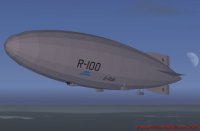Airships
After serving an engineering apprenticeship in shipyards on the Thames and at John Samuel White’s shipyard on the Isle of Wight, Wallis was working as a draughtsman there when he met H.B. Pratt, who had previously worked at the Vickers armaments company at Barrow-in-Furness. With World War I looming, the Admiralty saw the potential of rigid airships for long-range maritime patrol, and ordered an airship similar to the successful German Zeppelins which had been flying for more than ten years. Having shown some flair for airship work, Pratt was invited back to Barrow, and he invited his new friend Wallis to join him. Together, they designed His Majesty’s Airship No.9 (HMA 9). Although Government and Admiralty interest in airships waxed and waned throughout the war, HMA 9 flew successfully, as did succeeding designs of airships, including the 23-class, also designed by Pratt and Wallis (four airships - HMA 23, HMA 24, HMA 25 and (following a change of nomenclature) R.26).
Towards the end of the war, and now far more experienced in airship design, Wallis departed from the design techniques that had been based on German practice, and designed the R.80, the most streamlined airship built up to that time. However, with the end of the war, support for airships (even for commercial purposes) was in short supply, and after a very brief operational career, R.80 was scrapped.
With aircraft still somewhat lacking in range, Government support for exploring an airship service across the Empire was eventually secured in 1924 in the Imperial Airship Scheme. Two airships were to be built and trialled against each other, the best elements from both being used to develop a second generation of airships. The ships were to have a speed of 70 knots and carry 100 passengers over a range of 3,000 miles. One ship was built by the Royal Airship Works at Cardington under direct Government control, and the other was built by the Airship Guarantee Company (a subsidiary of Vickers) on a wholly commercial basis, with Wallis as Chief Designer. Although built to the same specification, and hence broadly similar with a length of over 700ft and a capacity of 5,000,000 cubic feet, Wallis’s R.100 and the Government R.101 were very different in the detail of their construction.
R.100's structure was fabricated in Duralumin (a light aluminium alloy) while most of R.101’s structure was stainless steel. R.101’s gasbags were held in place by a novel parachute-type harness, while Wallis developed a geodetic wire mesh for R.100 to give greater gasbag volume (and hence more lift).
The production engineering techniques which Wallis had pioneered on R.80 were further developed on R.100 - most of R.100's structure was built from just 11 components (which could thus be mass-produced in their millions) and the entire structure was built from just 41 different components. Duralumin tubes of the length Wallis required were not available, so he designed a machine which would take flat Duralumin strip (which was available in long lengths), form it into a helix, and rivet the edges together to form a tube.
In the summer of 1930, following successful trials, R.100 flew to Canada and back, also undertaking a flight over the United States. R.101’s trials had been less satisfactory as she was too heavy, and it was decided to add an extra section into her structure to give more lift. This was completed in the autumn, and after brief trials, she was declared fit for a trip to India. After leaving Cardington in the afternoon of 4th October, R.101 encountered stormy weather over northern France early the following morning, and this caused the ship to strike the ground, whereupon she was consumed by fire (unlike the Hindenburg crash, which was caused by a fire starting while still airborne). 48 of the 54 on board, including the Air Minister Lord Thomson, were killed. Interest in continuing with the Imperial Airship Scheme ebbed away, and in 1931, R.100 was deflated and scrapped, her girders being flattened by a steam roller.
This was the end of rigid airships in the UK (although American and German interest continued until the Hindenburg crash in 1937), and so Wallis’s position as Britain’s greatest rigid airship designer has remained unchallenged.








